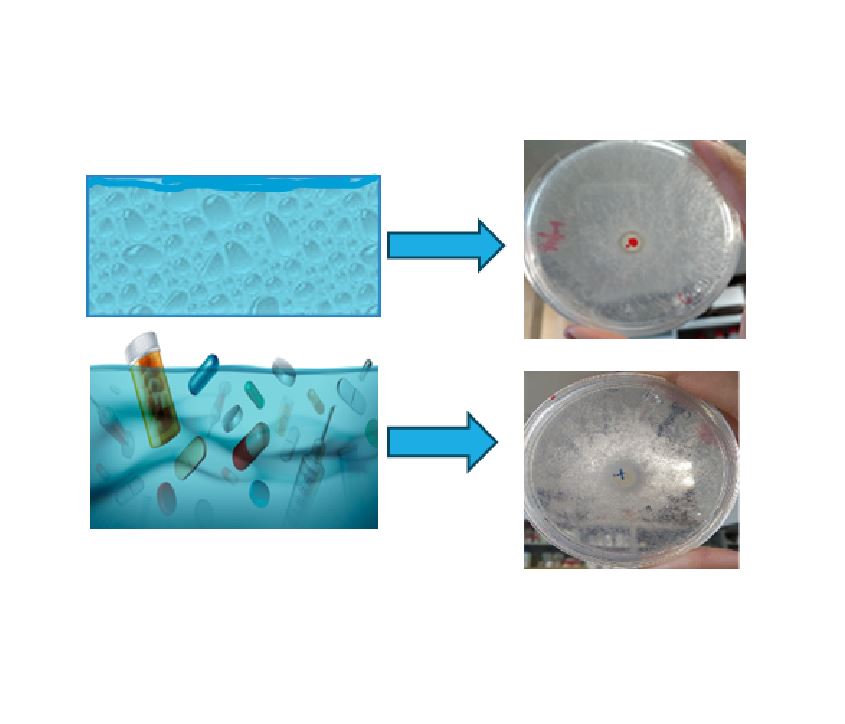Modelado del crecimiento radial de Amyomyces rouxii y su tolerancia a compuestos activos farmacéuticos seleccionados
DOI:
https://doi.org/10.18633/biotecnia.v26.2292Palabras clave:
microcontaminantes, ecuación logística, hongos, inhibición del crecimiento, modelado del crecimienroResumen
Los hongos filamentosos que toleran la presencia de compuestos activos farmacéuticos (CAFs) podrán potencialmente removerlos. El objetivo fue mostrar que los datos de crecimiento radial pueden ser modelados y usados para determinar los parámetros cinéticos del crecimiento fúngico en presencia de CAFs y evaluar la inhibición del crecimiento por los CAFs. Se evaluó la capacidad de Amylomyces rouxii para crecer en presencia de 12 CAFs a concentraciones entre 100 a 5000 µg L-1. Los CAFs estudiados fueron paracetamol, ibuprofeno, naproxeno, sulfametoxazol, trimetoprima, ciprofloxacino, ofloxacino, carbamazepina, B-estradiol, triclosán y bisfenol A. Los datos del crecimiento radial de A. rouxii fueron modelados usando la ecuación logística y se obtuvo la tasa máxima de crecimiento. A 24 h, se calculó la inhibición del crecimiento. Ibuprofeno, trimetoprima, y B-estradiol no causaron inhibición. La carbamazepina, 5000 µg L-1, inhibió completamente el crecimiento de A. rouxii. Hasta donde sabemos, este es el primer trabajo que informa de la toxicidad de los CAFs en hongos.
Descargas
Citas
Argumedo-Delira, R., Alarcón, A., Ferrera-Cerrato, R., Almaraz, J.J., Peña-Cabriales, J.J. 2012. Tolerance and growth of 11 Trichoderma strains to crude oil, naphthalene, phenanthrene and benzo [a] pyrene. Journal of environmental management, 95, S291-S299.
Baldrian P. 2003. Interactions of heavy metals with white-rot fungi. Enzyme Microbial and Technologu 32, 78-91.
Burkina, V., Sakalli, S., Pilipenko, N., Zlabek, V., Zamaratskaia, G. 2018. Effect of human pharmaceuticals common to aquatic environments on hepatic CYP1A and CYP3A-like activities in rainbow trout (Oncorhynchus mykiss): An in vitro study. Chemosphere, 205, 380-386.
Calderón, A., Meraz, M., Tomasini, A. 2019. Pharmaceuticals Present in Urban and Hospital Wastewaters in Mexico City. Journal of Water Chemistry and Technology, 41(2), 105-112.
Crane, S., Dighton, J., Barkay, T. 2010. Growth responses to and accumulation of mercury by ectomycorrhizal fungi. Fungal Biol, 114(10), 873-80.
de Lima Souza, H.M., Barreto, L.R., da Mota, A.J., de Oliveira, L.A., dos Santos Barroso, H., Zanotto, S.P. 2017. Tolerance to Polycyclic Aromatic Hydrocarbons (PAHs) by filamentous fungi isolated from contaminated sediment in the Amazon region. Acta Scientiarum. Biological Sciences, 39(4), 481-488.
Gabiatti Jr, C., Vendruscolo, F., Piaia, J.C.Z., Rodrigues, R., Durrant, L., Costa, J.A.V. 2006. Radial growth rate as a tool for the selection of filamentous fungi for use in bioremediation. Brazilian Archives of Biology and Technology, 49, 29-34.
Hai, F.I., Yang, S., Asif, M.B., Sencadas, V., Shawkat, S., Sanderson-Smith, M., Gorman, J., Xu, Z.-Q., Yamamoto, K. 2018. Carbamazepine as a Possible Anthropogenic Marker in Water: Occurrences, Toxicological Effects, Regulations and Removal by Wastewater Treatment Technologies. Water, 10(2), 107.
Hendricks, K.E., Christman, M.C., Roberts, P.D. 2017. A statistical evaluation of methods of in-vitro growth assessment for Phyllosticta citricarpa: average colony diameter vs. area. PloS one, 12(1), e0170755.
Jos, A., Repetto, G., Rios, J., Hazen, M., Molero, M., Del Peso, A., Salguero, M., Fernández-Freire, P., Pérez-Martın, J., Cameán, A. 2003. Ecotoxicological evaluation of carbamazepine using six different model systems with eighteen endpoints. Toxicology in Vitro, 17(5-6), 525-532.
Kim, Y., Choi, K., Jung, J., Park, S., Kim, P.-G., Park, J. 2007. Aquatic toxicity of acetaminophen, carbamazepine, cimetidine, diltiazem and six major sulfonamides, and their potential ecological risks in Korea. Environment International, 33(3), 370-375.
León-Santiesteban, H., Bernal, R., Fernández, F.J., Tomasini, A. 2008. Tyrosinase and peroxidase production by Rhizopus oryzae strain ENHE obtained from pentachlorophenol-contaminated soil. Journal of Chemical Technology & Biotechnology, 83(10), 1394-1400.
Li, Z., Zlabek, V., Velisek, J., Grabic, R., Machova, J., Kolarova, J., Li, P., Randak, T. 2011. Acute toxicity of carbamazepine to juvenile rainbow trout (Oncorhynchus mykiss): effects on antioxidant responses, hematological parameters and hepatic EROD. Ecotoxicol Environ Saf. , 43(3), 319-327.
Mehinto, A.C., Hill, E.M., Tyler, C.R. 2010. Uptake and biological effects of environmentally relevant concentrations of the nonsteroidal anti-inflammatory pharmaceutical diclofenac in rainbow trout (Oncorhynchus mykiss). Environ Sci Technol, 44(6), 2176-82.
Montiel, A.M., Fernández, F.J., Marcial, J., Soriano, J., Barrios-González, J., Tomasini, J. 2004. A fungal phenoloxidase (tyrosinase) involved in pentachlorophenol degradation. Biotechnology Letters, 26, 1353-1357.
Ruiz-Lara, A., Fierro, F., Carrasco, U., Oria, J.A., Tomasini, A. 2020. Proteomic analysis of the response of Rhizopus oryzae ENHE to pentachlorophenol: Understanding the mechanisms for tolerance and degradation of this toxic compound. Process Biochemistry, 95, 242-250.
Russo, F., Ceci, A., Pinzari, F., Siciliano, A., Guida, M., Malusà, E., Tartanus, M., Miszczak, A., Maggi, O., Persiani, A.M. 2019. Bioremediation of dichlorodiphenyltrichloroethane (DDT)-contaminated agricultural soils: Potential of two autochthonous saprotrophic fungal strains. Applied and environmental microbiology, 85(21).
Sagar, V., & Singh, D. P. . 2011. Biodegradation of lindane pesticide by non white- rots soil fungus Fusarium sp. World journal of microbiology & biotechnology, 27(8), 1747-1754.
Santos, L.H., Araújo, A.N., Fachini, A., Pena, A., Delerue-Matos, C., Montenegro, M.C. 2010. Ecotoxicological aspects related to the presence of pharmaceuticals in the aquatic environment. Journal of hazardous materials, 175(1-3), 45-95.
Tomasini, A., & León-Santiesteban, H.H. (Eds.). (2019). Fungal Bioremediation: Fundamentals and Applications (1st ed.). CRC Press. https://doi.org/10.1201/9781315205984. 2019. The Role of the Filamentous Fungi in Bioremediation. in: Fungal Bioremediation: Fundamentals and Applications (Ed.) A. Tomasini, & León-Santiesteban, H.H. , CRC Press Taylor & Francis Group. Boca Raton, FL pp. 3.
Tomasini, A., Flores, V., Cortés, D., Barrios-González, J. 2001. An isolate of Rhizopus nigricans capable of tolerating and removing pentachlorophenol. World Journal of Microbiology and Biotechnology, 17(2), 201-205.
Zhang, W., Zhang, M., Lin, K., Sun, W., Xiong, B., Guo, M., Cui, X., Fu, R. 2012. Eco-toxicological effect of Carbamazepine on Scenedesmus obliquus and Chlorella pyrenoidosa. Environmental toxi-cology and pharmacology, 33(2), 344-352

Descargas
Archivos adicionales
Publicado
Cómo citar
Número
Sección
Licencia
Derechos de autor 2023

Esta obra está bajo una licencia internacional Creative Commons Atribución-NoComercial-CompartirIgual 4.0.
La revista Biotecnia se encuentra bajo la licencia Atribución-NoComercial-CompartirIgual 4.0 Internacional (CC BY-NC-SA 4.0)









_(2).jpg)





